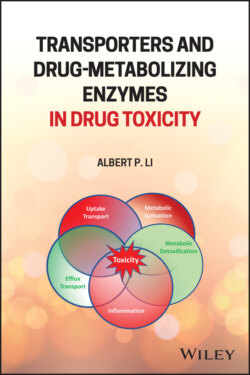Читать книгу Transporters and Drug-Metabolizing Enzymes in Drug Toxicity - Albert P. Li - Страница 32
2.3.4.3 Time Dependent Inactivation of CYP450 Enzymes
ОглавлениеOccasionally the formed RMs (electrophiles) are so highly reactive that they cannot flow out from the active site of the P450 enzymes that catalyzed their formation. Electrophilic intermediates derived from drug molecules are so reactive that they can covalently bind directly to an active site amino acid residue in the CYP enzyme itself. Covalent modification in the active site of a P450 enzyme may lead to the loss of enzyme activity over time via the modification of the P450 apoprotein. Therefore, time dependent inactivation (TDI) of CYP450 enzymes and other drug‐metabolizing enzymes also indicates the generation of RMs during the drug metabolism process. Additionally, drug–drug interactions could be caused by this irreversible P450 inhibition. Covalent modification of P450 enzymes can also result in a neoantigen formation and trigger an autoimmune response in DILI.
The TDI assay is a two‐step assay in which the drug of interest is preincubated with a source of P450 enzymes, such as human liver microsomes. This method can detect two scenarios for TDI: (i) time dependent loss of CYP activity following incubation at a single compound concentration; and (ii) an IC50 shift after preincubation at multiple concentrations. In the first step the tested compound is preincubated at multiple concentrations in the in vitro incubation of human liver microsome in the presence and absence of β‐nicotinamide adenine dinucleotide 2′‐phosphate reduced tetrasodium salt (NADPH) for a preset time period (usually ∼30 minutes). The second step is the measurement of CYP450 activity using a probe CYP substrate. The IC50 values upon preincubation were calculated in the presence and absence of NADPH cofactor, and a decrease in IC50 will suggest the presence of TDI of CYP450 enzymes.
Electrophile trapping experiments are typically used for the stable conjugates of RMs. If a certain amount of formed RMs cannot escape the active site of the P450 enzymes, the trapping assays usually are not able to detect the RMs associated with the inactivation of P450 enzymes. The TDI assay therefore can supplement the electrophile trapping assay in detecting RM formation. Nakayama et al. [21] demonstrated that the combination of TDI assays and GSH trapping assays significantly correlated with the extent of covalent binding assay (r = 0.77, P < 0.0001), but both alone are not correlated, suggesting the combination of these two assays provides an alternative to the covalent binding assay for identifying RM formation by the drug molecules.
